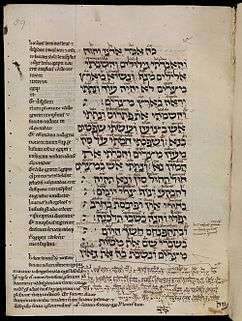Ezekiel 1
| Ezekiel 1 | |
|---|---|
 Book of Ezekiel 30:13–18 in an English manuscript from the early 13th century, MS. Bodl. Or. 62, fol. 59a. A Latin translation appears in the margins with further interlineations above the Hebrew. | |
| Book | Book of Ezekiel |
| Bible part | Old Testament |
| Order in the Bible part | 26 |
| Category | Nevi'im |
Ezekiel 1 is the first chapter of the Book of Ezekiel in the Hebrew Bible or the Old Testament of the Christian Bible. This book contains the prophecies spoken by the prophet Ezekiel, and is a part of the Book of the Prophets.[1] In the New King James Version, this chapter is sub-titled "Ezekiel’s Vision of God".[2]
Text
- The original text is written in Hebrew language.
- This chapter is divided into 28 verses.
Textual versions
Some most ancient manuscripts containing this chapter in Hebrew language:
- Masoretic Text
- Codex Cairensis (895 CE)
- Aleppo Codex (10th century)
- Leningrad Codex (1008-1009)
- Dead Sea Scrolls: (2nd century BC[3]
Ancient translations in Koine Greek:
- Septuagint
- Theodotion version (~AD 180)
Verse 1
- Now it came to pass in the thirtieth year, in the fourth month, in the fifth day of the month, as I was among the captives by the river of Chebar, that the heavens were opened, and I saw visions of God.[6]
- Rashi suggests that the thirty years are counted "from the beginning of the jubilee cycle", the last of which was started "at the beginning of the eighteenth year of Josiah‘s reign; that is, the year that Hilkiah found the scroll" (2 Kings 22), based on Seder Olam (chapter 26), and also based on Ezekiel 40:1 : “In the twenty-fifth year of our exile, at the beginning of the year, on the tenth of the month.” which the rabbis said (Arachin 12a) denoting the jubilee year (Leviticus 25:9), that the prophet uses for his reference of time counting.[7]
Verse 2
- In the fifth day of the month, which was the fifth year of king Jehoiachin's captivity,[8]
- "In the fifth day of the month, which was the fifth year": Rashi wrote that this phrase, this verse and the next are not Ezekiel's words but an added interruption.[7]
Verse 3
- The word of the Lord came expressly unto Ezekiel the priest, the son of Buzi,
- in the land of the Chaldeans by the river Chebar;
- and the hand of the Lord was there upon him.[9]
Verse 5
- Also out of the midst thereof came the likeness of four living creatures.
- And this was their appearance; they had the likeness of a man.[12]
- "Living creatures": New Oxford Annotated Bible identified these as "Cherubim" (Ezekiel 10:15,20), although "uncharacteristically...have four faces" (Ezekiel 1:10; Revelation 4:7).[13]
Verse 26
- And above the firmament that was over their heads was the likeness of a throne,
- as the appearance of a sapphire stone:
- and upon the likeness of the throne was the likeness as the appearance of a man above upon it. (KJV)[14]
- "Sapphire" (Hebrew: ספיר sap-pîr): "a kind of gem"; "lapis lazuli" (Exodus 24:10; Ezekiel 28:18).[15][16]
Verse 28
- As the appearance of the bow that is in the cloud in the day of rain,
- so was the appearance of the brightness round about.
- This was the appearance of the likeness of the glory of the Lord.
- And when I saw it, I fell upon my face,
- and I heard a voice of one that spake.[17]
See also
|
- Related Bible parts: 2 Kings 24, 2 Chronicles 36, Isaiah 6, Jeremiah 29, Ezekiel 10, Ezekiel 11, John 12, Revelation 4, Revelation 21
Notes and references
- ↑ Theodore Hiebert, et al. 1996. The New Interpreter's Bible: Volume VI. Nashville: Abingdon.
- ↑ Ezekiel 1:1-28: NKJV
- ↑ Timothy A. J. Jull; Douglas J. Donahue; Magen Broshi; Emanuel Tov (1995). "Radiocarbon Dating of Scrolls and Linen Fragments from the Judean Desert". Radiocarbon. 38 (1): 14. Retrieved 26 November 2014.
- ↑ Ulrich 2010, p. 584-585.
- ↑ Ulrich 2010, p. 584.
- ↑ Ezekiel 1:1, King James Version
- 1 2 Rashi's commentary on Ezekiel 1:1-2.
- ↑ Ezekiel 1:2
- ↑ Ezekiel 1:3
- ↑ Brown, 1994 & "הָיָה".
- ↑ Gesenius, 1979 & "הָיָה".
- ↑ Ezekiel 1:5
- ↑ The New Oxford Annotated Bible with the Apocrypha, Augmented Third Edition, New Revised Standard Version, Indexed. Michael D. Coogan, Marc Brettler, Carol A. Newsom, Editors. Publisher: Oxford University Press, USA; 2007. pp. 1182-1184 Hebrew Bible. ISBN 978-0195288810
- ↑ Ezekiel 1:26
- ↑ Brown, 1994 & "סַפִּיר".
- ↑ Gesenius, 1979 & "סַפִּיר".
- ↑ Ezekiel 1:28
Bibliography
- Brown, Francis; Briggs, Charles A.; Driver, S. R. (1994). The Brown-Driver-Briggs Hebrew and English Lexicon (reprint ed.). Hendrickson Publishers. ISBN 978-1565632066.
- Gesenius, H. W. F. (1979). Gesenius' Hebrew and Chaldee Lexicon to the Old Testament Scriptures: Numerically Coded to Strong's Exhaustive Concordance, with an English Index. Translated by Tregelles, Samuel Prideaux (7th ed.). Baker Book House.
- Ulrich, Eugene, ed. (2010). The Biblical Qumran Scrolls: Transcriptions and Textual Variants. Brill.
External links
Jewish
Christian
This article is issued from
Wikipedia.
The text is licensed under Creative Commons - Attribution - Sharealike.
Additional terms may apply for the media files.